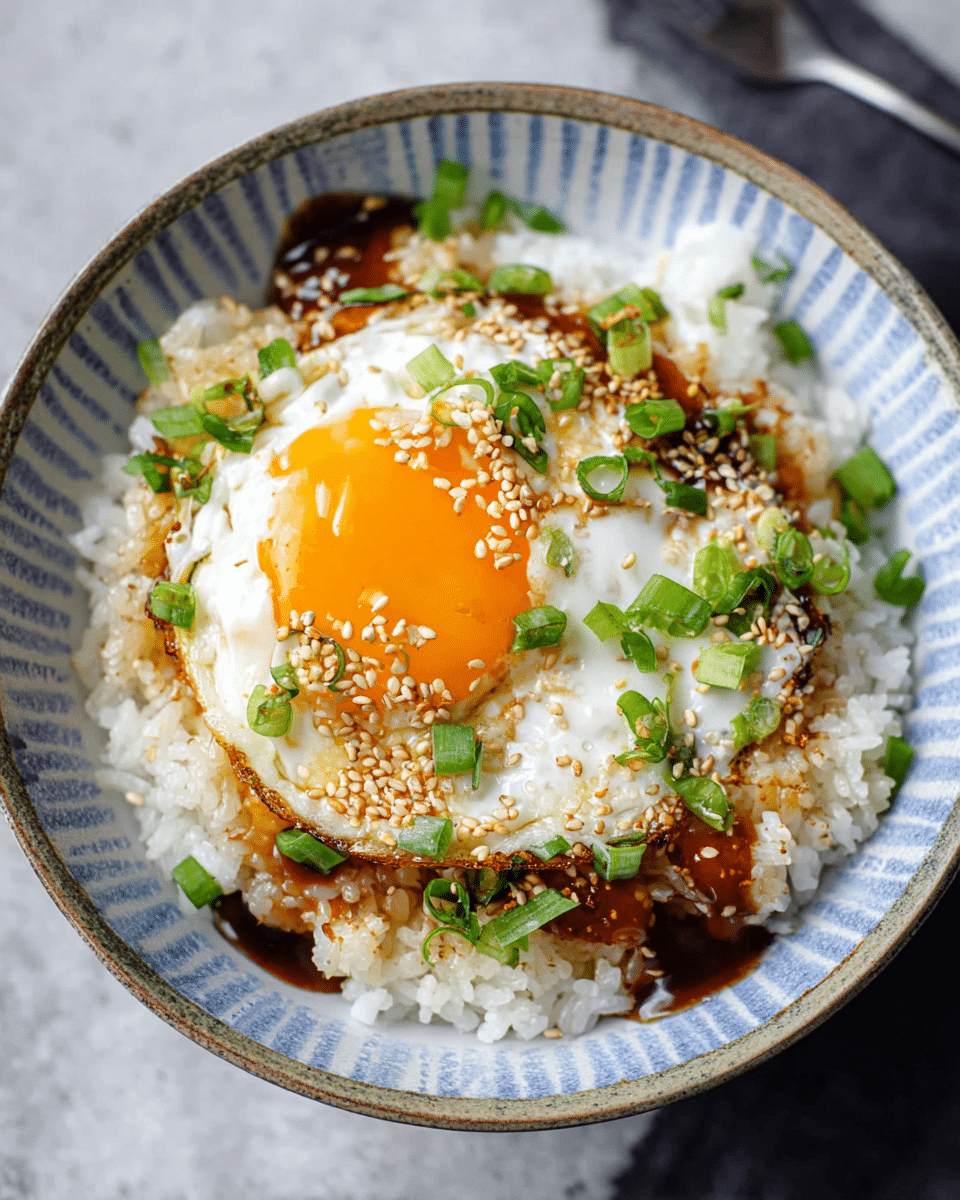The humble Gyeran Bap is a beloved Korean comfort food made with nothing more than a fried egg, buttered rice, and the bold umami hit of soy sauce and sesame oil. Incredibly fast and simple, it’s the dish many turn to when time and energy are in short supply but flavor is still a priority.
Perfectly runny yolks mix beautifully with the warm rice, creating a creamy, savory experience that feels indulgent despite the minimalist approach. This dish isn’t just breakfast it’s soul food, reimagined with pantry staples in under 10 minutes.
Full Recipe:
Ingredients:
-
1 ½ cups cooked short grain rice (or jasmine rice)
-
1 egg
-
1 tbsp unsalted butter
-
½ tsp sesame oil (toasted)
-
1 tbsp soy sauce (regular or low sodium)
-
1 tsp toasted sesame seeds
-
1 tbsp chopped green onions
-
½ tsp neutral oil (like vegetable, canola, or sunflower)
Directions:
-
In a large bowl, mix freshly cooked or microwaved hot rice with the butter until it melts and combines evenly.
-
Heat neutral oil in a non-stick pan over medium heat. Crack in the egg and fry sunny side up or to your preference. Spoon hot oil over the whites to set them while keeping the yolk runny.
-
Place the fried egg on top of the buttered rice.
-
Drizzle with soy sauce and sesame oil, then sprinkle with green onions and sesame seeds.
-
Break the yolk and mix everything well in the bowl. Serve hot and enjoy!
Prep Time: 5 minutes | Cooking Time: 5 minutes | Total Time: 10 minutes
Kcal: 562 kcal | Servings: 1 serving
Gyeran Bap: The Comforting Simplicity of Korean Egg Rice
In the heart of Korean cuisine lies a comforting dish known not for its extravagance, but for its simplicity, warmth, and soul soothing flavor: Gyeran Bap. Translated directly as “egg rice,” Gyeran Bap is a humble meal of steamed white rice topped with a fried or soft boiled egg, seasoned with soy sauce, sesame oil, and garnished with green onions and sesame seeds. But within this modest bowl lies a deeper story of culture, comfort, and culinary adaptability.
A Taste of Korean Home Cooking
Gyeran Bap is not typically the kind of dish you’ll find on restaurant menus. Instead, it’s one of the truest examples of Korean home cooking. It’s the kind of meal that Korean children grow up eating, a staple for students, workers, and parents alike. It’s what you turn to when the fridge is nearly empty, when you’re pressed for time, or when you’re simply craving something warm and satisfying.
There’s an undeniable emotional attachment many Koreans have with Gyeran Bap. It’s the food of early mornings before school, of late-night cravings, and of rushed workday lunches. It evokes a sense of nostalgia that only true comfort food can. Much like how peanut butter and jelly sandwiches hold sentimental value in the West, Gyeran Bap does the same in Korean households.
Why Gyeran Bap is So Popular
The appeal of Gyeran Bap is rooted in several key attributes:
-
Speed: You can make it in under 10 minutes, especially if you already have leftover rice. That’s a huge win for busy people.
-
Affordability: The dish relies on staple pantry ingredients rice, eggs, soy sauce, and oil which makes it accessible to virtually anyone.
-
Flavor Harmony: The buttery richness of the yolk, the umami depth of soy sauce, and the nutty notes of sesame oil come together in a way that feels indulgent without being heavy.
-
Customizability: It acts as a blank canvas. You can add spicy gochujang, kimchi, tuna, avocado, or even shredded nori to make it uniquely yours.
It’s rare to find a dish that’s so simple, yet so full of character and versatility.
The Flavor Profile: Rich, Savory, and Balanced
At first glance, Gyeran Bap might look basic. But each component plays a key role in its flavor makeup.
The steamed rice provides the foundational texture soft, sticky, and neutral enough to absorb the other flavors. A fried egg, usually sunny side up, delivers both creaminess and a slight crispness on the edges. When you break the yolk and mix it into the rice, it creates a natural sauce that adds both moisture and body.
The soy sauce introduces saltiness and umami, while sesame oil lends a toasted, nutty aroma that gives the dish depth. Green onions and sesame seeds offer freshness and texture. The result is a bowl of rice that is buttery, savory, slightly sweet, and packed with layers of subtle flavor.
A Perfect Any Time of Day Dish
While Gyeran Bap is commonly eaten for breakfast, it’s really an anytime of day meal. Many Koreans enjoy it for lunch, dinner, or even as a late-night snack. Its versatility allows it to serve different roles throughout the day.
-
For Breakfast: It’s light enough to eat first thing in the morning but hearty enough to keep you full for hours.
-
For Lunch: Paired with some kimchi or a quick vegetable side dish, it makes for a satisfying midday meal.
-
For Dinner: When you’re tired and don’t want to cook, it hits the spot without the fuss.
-
For Late Night: It’s warm, fast, and comforting everything you want in a midnight bowl.
Nutritional Benefits
While it’s not a salad or smoothie, Gyeran Bap actually holds its own nutritionally. A single serving typically contains around 550–600 calories, depending on how much oil or butter is used. It offers:
-
Carbohydrates for quick energy from the rice
-
Protein and essential amino acids from the egg
-
Healthy fats from sesame oil and butter
-
Micronutrients like B vitamins, selenium, and choline
It can easily be adjusted for different dietary needs. Want it lower in fat? Skip the butter or use a non-stick pan. Need more protein? Add another egg or toss in some tofu. Watching sodium? Use low-sodium soy sauce or tamari.
Make It Your Own: Endless Variations
One of the most appealing aspects of Gyeran Bap is how infinitely customizable it is. Here are just a few popular or creative additions:
-
Kimchi – Adds spice, tanginess, and probiotics
-
Gochujang – Korean chili paste for heat and umami
-
Tuna or Canned Salmon – Protein boost and richness
-
Avocado – Creamy and healthy fat
-
Sautéed Veggies – Carrots, mushrooms, zucchini, or spinach for nutrition and texture
-
Cheese – Melts beautifully into the rice and egg for extra comfort
-
Seaweed Flakes or Furikake – Adds a crunch and umami punch
These additions transform Gyeran Bap from a simple dish into a gourmet rice bowl that can rival the most sophisticated grain bowls on any menu.
Cultural Insight: What It Represents
Beyond its taste and ease, Gyeran Bap carries with it the essence of Korean food culture. At its core, Korean cuisine is about balance between flavors, textures, and even hot and cold elements. Gyeran Bap reflects that philosophy with its soft rice, creamy egg, savory seasonings, and the potential to add cool, crunchy or spicy toppings.
It’s also representative of the Korean value of frugality and resourcefulness. Nothing goes to waste. Leftover rice becomes the base. A single egg becomes the star. With just a few pantry staples, something nourishing and delicious is born.
Even in an age of food delivery apps and global fusion menus, dishes like Gyeran Bap remind us that sometimes, the most satisfying meals come from the simplest places your own kitchen.
Tips for Making the Best Gyeran Bap
While there’s no wrong way to make it, a few tips can elevate your bowl:
-
Use freshly cooked or hot rice: It helps the butter melt more evenly and makes mixing easier.
-
Keep the egg yolk runny: This adds a creamy sauce-like consistency when mixed in.
-
Use toasted sesame oil: It’s more aromatic and elevates the flavor.
-
Use a large bowl: Mixing is much easier without ingredients falling out.
-
Balance your toppings: Don’t overload let each component shine.
Conclusion:
Gyeran Bap is more than just an egg on rice it’s a reflection of the Korean spirit: resilient, efficient, deeply flavorful, and endlessly adaptable. It may not require a lot of ingredients or time, but it offers everything you want in a meal comfort, nourishment, and satisfaction.
Whether you’re new to Korean cuisine or already a fan, Gyeran Bap is a dish that invites you in, asks for very little, and gives back so much. Try it once, and it’s likely to become a go-to in your own kitchen, just as it has been in countless homes across Korea for generations.






